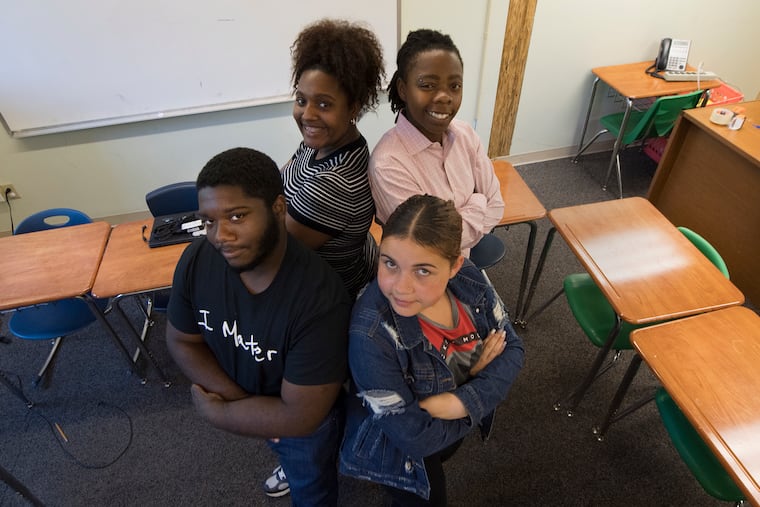School’s out, but these foster kids don’t want to leave | Ronnie Polaneczky
"Don't think that because you haven't achieved that you're not intelligent. What you are is under-educated, and we're going to help you change that."

Now that the school year has ended, don't expect Siyanna Torres to sing that old ditty about "No more pencils, no more books, no more teacher's dirty looks."
She loves C.B. Community School so much that she doesn't want to leave for the summer.
"At my old school, no one even knew my name," says Siyanna, 18. "Here, they know my life. They can take one look at me and say: 'Are you OK? You don't seem like yourself. What's going on?' "
Those simple questions turn out to be game-changers for teens like Siyanna, who are veterans of the city's foster-care system.
C.B. which stands for "competency based," is a tiny gem of a private high school in Manayunk for 67 kids who have been involved in Philly's foster-care system. (The system can include placement with a family, or in group homes or institutions, the latter of which currently house about 900 Philadelphia children.)
In and around classes, C.B. students receive services from a full-time guidance counselor, nurse, and social worker. These specialists provide trauma-informed care to students whose lives are complicated by poverty, abandonment, illness, early parenthood, grief, violence, and stress.
"We're often the most stable, consistent part of our students' lives," says school founder Roberta Trombetta, who raises $1.5 million a year from private donors to fund the school, which is free to students. "They move around so much, they sometimes bring their belongings to school because they don't know where they'll be staying that night."
The frequent moves can tank a teen's education. Youths in the foster-care system often find themselves furthest behind their peers academically, says Maura McInerney, legal director of the Education Law Center.
That's because the on-site educational programming at most residential institutions is a farce. At a City Council hearing last month about the safety and educational issues at these facilities, McInerney described how the "curriculum" is often taught in multigrade classrooms, is far below grade level, limited in instruction hours, relies heavily on worksheets, and fails to advance basic skills.
"This prevents [students] from developing critical skills, building knowledge, and staying on track to graduate. They give up and drop out of school," McInerney said. "It is a loss that follows them and harms them for the rest of their lives."
They find little support when they return home and reenroll in their big, anonymous neighborhood schools.
"I went to my high school only for a month," says C.B. student I-sha-le Watson, 18, whose father is in prison and who entered foster care when her mom got sent away, too. "There were fights in the classroom; the teachers were always arguing with the kids. When I left, no one even noticed."
At C.B., students will run into others who were once institutionalized with them. The day I visited, Siyanna and I-sha-le joined fellow students Bria Kelly, 18, and Amun Jones-Bey, 18, to recall their days in placement together.
I-sha-le described being humiliated by a staffer who, when she confronted him about unfair treatment, would taunt her with "At least I live in a real home. At least my family loves me."
Bria, 18, shook her head in disgust.
"I hate when they do that," she said.
Many teens in placement have babies, and that can lead to friction with staff, says Siyanna.
"Any little thing you do wrong, they say they're going to 'ChildLine' you' " – file a report to the agency that investigates child abuse – for something as simple as a baby's diaper rash. "It's like they want us to fail."
Bria tried, to no avail, to let her tormenters know she deserved respect, not contempt.
"I told them: 'I'm not here because I did anything wrong. I'm trying to improve my life, and this is how you treat me?' "
It's no wonder teens are wary when they get to C.B. It took Amun a long time to trust the school's staff. Three years later, he regards them as family.
"I never would have made it in a big school," says Amun, whose shy demeanor masks a brilliance that's obvious once he opens his mouth.
C.B.'s principal, Vicki Rodney, herself a child of the foster-care system, understands her students well. They spend hours in her cozy office, pouring out their pain as they come to grips with how badly the adults in their lives have let them down.
"Underneath all their bravado is a deep wanting to belong," Rodney says. "They're sad and angry."
C.B.'s approach seems to be working. A pilot study by C.B. and the Department of Human Services, which oversees all children in care, found that C.B. students had higher rates of school attendance and engagement than they had had at their prior, traditional schools.
"Roberta [Trombetta] has done an extraordinary thing, which is create an incredibly warm, nurturing, and loving school environment for a difficult-to-serve population of students," says DHS Commissioner Cynthia Figueroa. She'd love to see its concept expanded in Philadelphia public schools, which would give kids a solid alternative to residential placement when they go truant.
On Thursday, City Council approved a resolution creating a task force on institutional youth placements to look at ways to better serve kids like Siyanna, I-sha-le, Bria, and Amun. C.B. Community School deserves to figure prominently in those discussions.
"These are vulnerable kids who want better for their lives," says Rodney. "Who they are right now is not who they will be in 10 years – but only if we do right by them today."